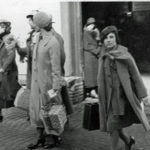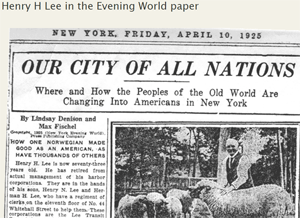My mother was born in Munich to a Jewish father and a Catholic mother so I know perfectly well why they moved to Boston in 1935. He was “retired” in the early 1930s, from his professorship at the University of Freiburg Faculty of Medicine for being jewish. However he still had an extensive private medical practice and would have stayed in Germany had my Oma not insisted that they leave. Thankfully my Opa was a prominent scientist and had many offers from different universities around the world. Happily for my existence, my Oma chose Boston over Ankara.
But why did my Norwegian ancestors come to this country? I recently started reading a book, Between Rocks and Hard Places
(love that title!) by Ann Urness Gesme that answers some of those questions and describes life in Norway in the 1800s in much detail. So I wanted to share this find with all of you other Norwegian Americans and Norwegians. Many of you may have already read the wonderful article Peace, Potatoes and Pox which summarizes the reasons for the population explosion in Norway such that there were too many people on too little land, the main impetus behind emigration. He wrote that article after reading Norway to America A History of the Migration
by Ingrid Semmingsen, a detailed and carefully researched book. [n.b. these book titles include my affiliate links]
My paternal grandfather was born in Kristiansand, Norway’s southernmost city, and came here when he was six years old with his family. He later married the daughter of Norwegian immigrants, one from near Drammen and the other from Etne, Hordaland. This gives me the pleasure of three different places in Norway to research for my family history.
I am fortunate to have the letters that grandfather wrote to my Dad during WWII which include a description of leaving Kristiansand in 1884: “… my grandfather brought us out in a row boat to the steamer lying out in the harbor all ready to leave for America” and “What America was I did not know, but I had imbibed enough of family talk to realize it was a land of plenty and an interesting place to go to.” Followed by a description of the crossing: “Well the Atlantic was rough and wild at times during July 1884 and our boat rolled and pitched in the heavy seas. I was tremendously impressed by the huge waves, which seemed like mountains to me.”
However my favorite part is where he described arriving in Brooklyn: “My first impression was naturally that of wonder at everything new and strange. It was a great adventure into new and different conditions. My second reaction was one I shared with my mother – that of disappointment at the dirt and filth in Brooklyn in the summer of 1884. Goats were walking the streets eating the paper that littered the street.” But then ” In our little Norsetown the streets were clean and in almost every house you would see potted geraniums or other flowers in the front windows. There were many poor people but they were clean and orderly, and there was no public display of poverty. I don’t remember having any language difficulty. English at the age of six came easy and naturally, but for many years we talked Norwegian at home.”
I have no idea why my Munson relatives all were such prolific writers of their experiences in this new country, but I often read and reread what I have from them posted on my family site. My aunt typed up the diary which that same grandad kept of his courtship of his wife Anna, the daughter of Norwegian emigrants. They dated by taking bicycle rides in 1900 Brooklyn. “Summer has been very pleasant so far. Have had many rides with Miss Lee to our mutual pleasure. Our ride today though, eclipsed all former ones in point of “loveliness,” The day was ideal and we were both in the best of spirits. This was a sort of “wild ride”, for leaving the boulevard, we passed over unknown roads and lanes. We passed cultivated fields and farms, and had a jolly good time.”
My uncle Alex inteviewed his grandad, H.H. Lee, Anna’s father, and got many details of his early life and emigration. He was a sailor from the age of fourteen until “In 1869, when he was seventeen years old, he jumped ship in Chatham, New Brunswick, Canada, and changed his name to Henry H. Lee. He had 75 cents in his pocket. He found employment in a plant where balsam was manufactured, and then in a steamy tanning plant. The balsam was for medicinal purposes, and the tanning of raw hides was for making leather. After three years in Canada, he journeyed to New York, at the age of twenty.” [from http://kittymunson.com/index.php?page=early-american-years ]. Apparently he did not find the opportunities in Canada much better than in Norway so moved on according to a newspaper article we have (click the image for the full article).
So why did Anna’s mother come to America from Skougar near Drammen? She came with her family to Florida but hated the climate so left them to seek employment in New York according to that same newspaper article above. The records indicate that her mother stayed behind in Norway. All but one of her siblings came to America but several returned to Norway much later on. Her father also went back rather quickly, see http://kittymunson.com/index.php?page=wold-family
So I have not really answered the question of why they all came to America, it seems like it was economic reasons that brought my various Norwegian ancestors to Brooklyn. I am hoping this book gives me more insight into that as well as their lives in Norway!



That article is amazing and so was he!
Do you know how he physically went from New Brunswick to Brooklyn? My 3x gr grandmother was born in St Johns and came to the USA via Brooklyn about 1820 but I cannot track her because I can’t figure out her surname prior to marrying my 3x gr grandfather. Any advice/info would be appreciated. Love the newspaper article! Immigrants Rock!!
Yes, they took the Hamilton Ferry across. Here is what he said in those letters, “After a while we moved on carrying bits of hand baggage and I was told we were going across the river in another boat. As we moved into the dock I expected to walk through to the boat, but was told to sit down and the whole dock then started to move. We were on the Hamilton Ferry, and in a short time landed in old Brooklyn where we were to spend many years for better or worse!
The link for my grandfather’s letters (linked above) is: http://kittymunson.com/index.php?page=monsen-emigration
Oh wait, you are asking about my other side, my great grandfather who jumped ship in Canada. He took the train (that is what I was told) but it seems more logical that he would have worked his way on a ship.
My g-g-grandfather came with his bride and his brother in 1852. Any idea of a route from NY to Manitowoc, WI? His bride evidently did NOT arrive in Manitowoc, as he married my g-g-grandmother there. Don’t think they were on the shipwreck in the Great Lakes. Thanks!
Anita –
Wikipedia discusses that many Norwegians went to the midwest via Quebec see https://en.wikipedia.org/wiki/Norwegian_Americans
But there was also the NY route via the river canal system see
http://norwegianridge.com/timeline-of-norwegian-immigration-and-settlement/
Also https://www.nb.no/emigrasjon/emigration/2nd_time2.html
Three of my wife’s grandparents came from Sweden and the other was the daughter of Swedish. I think reasons for leaving were the same as for Norway.
I believe some of my German ancestors were avoiding conscription into the Prussian army. My Irish ancestors probably emigrated due to the potato blight. I have no documentation as to why they came.
At that time, did they need permission from the USA to enter the country or did they just come?
Kitty,
You are so lucky to have personal letters and writings from your ancestors. Your great fortune in “knowing” their dreams and day to day life. My great grandma arrived in America in 1901 from Sweden. I have spent years trying to trace her without success until DNA tests brought me to a Swedish 3rd cousin.
Best wishes
Around 1850, my father’s family came south into the US from Canada. No permission needed. In 1912, my grandmother came from Denmark through Ellis Island. Another immigration facility existed in 1855 til 1890 and processed in excess of 8 million people coming to the promised land through New York.
My ancestors came here in 1620,on the Mayflower